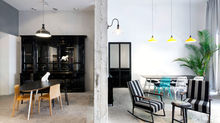Mastering the Art of Retail: A Comprehensive Guide to Effective Retail Interior Design
- zxinteriors6
- Mar 17, 2024
- 3 min read
Introduction
Retail interior design is a crucial aspect of creating memorable shopping experiences and driving sales in today's competitive market· The layout, ambiance, and aesthetics of a retail space can significantly influence consumer behavior and perceptions· In this comprehensive guide, we delve into the key principles and strategies for mastering the art of Retail Interior Design in Dubai, aiming to help businesses create inviting, functional, and profitable retail environments·

Understanding the Importance of Retail Interior Design
Effective retail interior design goes beyond merely arranging products on shelves· It encompasses a holistic approach that considers factors such as customer flow, brand identity, merchandise presentation, and ambiance· A well-designed retail space not only attracts customers but also enhances their overall shopping experience, leading to increased satisfaction and loyalty·
Creating a Cohesive Brand Identity
The first step in retail interior design is to establish a cohesive brand identity that resonates with the target audience· The design elements, color schemes, and overall aesthetic should reflect the brand's values, mission, and personality· Whether it's a luxury boutique or a trendy pop-up store, consistency in branding helps create a memorable and recognizable retail environment·
Optimizing Layout and Traffic Flow
A well-thought-out layout is essential for optimizing traffic flow and guiding customers through the retail space· Retailers should consider factors such as sightlines, product placement, and navigation paths to ensure a seamless and intuitive shopping experience· By strategically placing high-demand items and creating focal points, retailers can encourage exploration and maximize sales opportunities·
Utilizing Visual Merchandising Techniques
Visual merchandising plays a vital role in retail interior design by showcasing products in an attractive and compelling manner· Techniques such as color blocking, storytelling displays, and themed vignettes can capture customers' attention and stimulate their desire to purchase· Additionally, incorporating sensory elements like lighting, music, and scent can create a multisensory experience that leaves a lasting impression on shoppers·
Enhancing Ambiance with Lighting and Décor
Lighting and décor are powerful tools for creating ambiance and setting the mood in a retail space· The right lighting can highlight key areas, create focal points, and evoke emotions, while carefully curated décor elements add personality and character to the environment· Whether it's warm and inviting or sleek and modern, the ambiance should align with the brand identity and target demographic·
Prioritizing Functionality and Comfort
While aesthetics is important, retail interior design should also prioritize functionality and comfort· Adequate space planning, ergonomic fixtures, and comfortable seating areas contribute to a positive shopping experience and encourage customers to linger longer· Additionally, amenities such as fitting rooms, restrooms, and customer service areas should be conveniently located and well-designed to meet shoppers' needs·
Embracing Technology and Innovation
Incorporating technology and innovation can elevate the retail experience and differentiate a store from its competitors· From interactive displays and digital signage to virtual reality fitting rooms and mobile payment options, retailers have a wide range of tech-driven solutions to enhance engagement and convenience for customers· By embracing new technologies, retailers can stay relevant and adapt to evolving consumer preferences·

Conclusion
Mastering the art of retail interior design requires a combination of creativity, strategy, and attention to detail· By understanding the importance of branding, optimizing layout and traffic flow, utilizing visual merchandising techniques, enhancing ambiance with lighting and décor, prioritizing functionality and comfort, and embracing technology and innovation, retailers can create inviting, memorable, and profitable retail environments· With a well-designed retail space, businesses can effectively engage customers, drive sales, and build lasting relationships that extend beyond the transaction·

























Comments